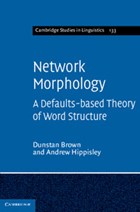Network Morphology
Overview
Network Morphology is a theoretical framework used to account for the irregularity and idiosyncrasy found in word structure. It describes the systems of rules which determine the morphological structure of words by construing irregularity as a matter of degree. The theory has been applied to a diverse range of languages and morphological phenomena.
Many languages share common word building strategies and many diverge in interesting ways. These strategies can be understood by distinguishing different notions of 'default' - a key notion in the theory of Network Morphology.
The Network Morphology philosophy promotes the use of computational implementation to check theories of morphological structure. This is usually conducted in a computational language known as DATR.
Publications on Network Morphology
The Network Morphology bibliography, comprising a list of publications and preprints, is available as a guide to major publications in Network Morphology.
A monograph on Network Morphology provides an overview of how the theory can be implemented, including DATR fragments on the accompanying website:
Brown, Dunstan & Andrew Hippisley. 2012. Network Morphology: A defaults-based theory of word structure. Cambridge: Cambridge University Press. Publisher's site
TOP


